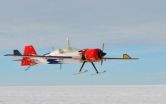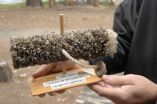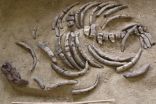(Press-News.org) The centimeter-sized fragments and smaller particles that make up the regolith — the layer of loose, unconsolidated rock and dust — of small asteroids is formed by temperature cycling that breaks down rock in a process called thermal fatigue, according to a paper published today in the Nature Advance Online Publication.
Previous studies suggested that the regolith of asteroids one kilometer wide and smaller was made from material falling to the surface after impacts and from boulders that were pulverized by micrometeoroid impacts. Recent laboratory experiments and impact modeling conducted by a team of researchers from Observatoire de la Côte d'Azur, Hopkins Extreme Materials Institute at Johns Hopkins University, Institut Supérieur de l'Aéronautique et de l'Espace and Southwest Research Institute (SwRI) have shown that the debris from large impacts reaches escape velocities and breaks free from the gravitational pull of these asteroids, indicating this mechanism is not the dominant process for regolith creation.
The team's research showed that thermal fragmentation, which is induced by mechanical stresses caused by temperature variations of the rapidly spinning asteroid's short night and day, to be the process primarily responsible for breaking up rocks larger than a few centimeters on asteroids.
"We took meteorites as the best analog of asteroid surface materials that we have on the Earth," said Dr. Marco Delbo of the Observatoire de la Côte d'Azur. "We then submitted these meteorites to temperature cycles similar to those that rocks experience on the surfaces of near-Earth asteroids and we found that microcracks grow inside these meteorites quickly enough to entirely break them on timescales much shorter than the typical lifetime of asteroids."
Model extrapolation of these experiments also showed that thermal fragmentation caused rocks to break down an order of magnitude faster than from micrometeoroid impacts, particularly at distances of 1 astronomical unit (about 93 million miles) with the speed of breakdown slowing at distances further from the Sun.
"Even asteroids significantly farther from the Sun showed thermal fatigue fragmentation to be a more relevant process for rock breakup than micrometeoroid impacts," said Dr. Simone Marchi, a scientist in the SwRI Space Science and Engineering Division.
The results of this study suggest that thermal fragmentation, combined with solar radiation pressures that sweep away surface particles, could completely erode small asteroids at distances closer to the Sun (about 28 million miles) in about 2 million years.
INFORMATION:
The French Agence National de la Recherche SHOCKS, BQR of the Observatoire de la Côte d'Azur, the University of Nice-Sophia Antipolis, the Laboratory GeoZur, the French National Program of Planetology, and NASA's Solar System Exploration Research Virtual Institute funded this research.
The paper "Thermal Fatigue as the Origin of Regolith on Small Asteroids," by Marco Delbo, Guy Libourel, Justin Wilkerson, Naomi Murdoch, Patrick Michel, K.T. Ramesh, Clement Ganino, Chrystele Verati, and Simone Marchi, (doi: 10.1038/nature13153) will be published in the April 10 print issue of Nature.
French, American team finds regolith of small asteroids formed by thermal fatigue
2014-04-02
ELSE PRESS RELEASES FROM THIS DATE:
Team identifies novel biomarker for head and neck cancer, non-small cell lung cancer
2014-04-02
JUPITER, FL, April 2, 2014 – A team led by a scientist from the Florida campus of The Scripps Research Institute (TSRI) has identified a new biomarker linked to better outcomes of patients with head and neck cancers and non-small cell lung cancer. The work could help scientists develop new diagnostics and therapies and help physicians determine the best long-term treatments for patients with these cancers.
The findings, which were published this week online ahead of print by the journal Cancer, focus on a protein called Choline phosphate cytidylyltransferase-α CCT-α ...
Going global
2014-04-02
KANSAS CITY, MO - In textbooks, the grand-finale of cell division is the tug-of-war fought inside dividing cells as duplicated pairs of chromosomes get dragged in opposite directions into daughter cells. This process, called mitosis, is visually stunning to observe under a microscope. Equally stunning to cell biologists are the preparatory steps cells take to ensure that the process occurs safely.
Molecular biologists define those "cell cycle" steps as: G1, when cells survey chromosomes for damage and, if they pass muster, prepare to replicate them; S phase, in which ...
New model shows moderate resource use & reduced economic inequality keys to sustainability
2014-04-02
COLLEGE PARK, MD - A new analytical tool adds human factors to a widely-used biological model of how animal populations interact, suggesting that human societies can reach a steady state that is sustainable when they do not over-deplete natural resources and avoid extreme economic inequality.
The paper, titled "Human and nature dynamics (HANDY): modeling inequality and use of resources in the collapse or sustainability of societies," was published in the May 2014 issue of the journal Ecological Economics. Its authors are Safa Motesharrei, a Ph.D. candidate in applied ...
One or 2? How to decide how many species you have got
2014-04-02
It is often difficult to decide whether two animals belong to the same or two distinct species. This can be especially challenging for animals which externally look very similar. In a recent study, published in the open access journal Zoosystematics and Evolution, scientists from the Museum für Naturkunde Berlin use genetic data and sound analysis to test if treefrogs from West and Central Africa belong to different or the same species.
Due to the fact that, when external characters are used, only size is useful to distinguish these frogs the scientists employed additional ...
Remotely operated aircraft successfully tested as tool for measuring changes in polar ice sheets
2014-04-02
Scientists studying the behavior of the world's ice sheets--and the future implications of ice sheet behavior for global sea-level rise--may soon have a new airborne tool that will allow radar measurements that previously would have been prohibitively expensive or difficult to carry out with manned aircraft.
In a paper published in the March/ April edition of IEEE Geoscience and Remote Sensing Magazine, researchers at the Center for Remote Sensing of Ice Sheets (CReSIS) at the University of Kansas noted that they have successfully tested the use of a compact radar system ...
Don't move a mussel (or a clam, or a snail)
2014-04-02
(Millbrook, NY) Anyone that has spent time at a seaside pier has witnessed the destruction barnacles wreak on boat hulls. But biofouling animals are not limited to marine environments. A new paper published in the journal Frontiers in Ecology and the Environment estimates that the global management of freshwater mussels, clams, and other clinging animals costs $277 million U.S. dollars annually.
Biofoulers are organisms that accumulate underwater on hard surfaces, to the detriment of property and economically important activities, such as shipping, power generation, ...
Beyond proficiency: How early English exposure influences non-native speakers
2014-04-02
PRINCETON, N.J.—Non-native speakers exposed to English before moving to America are more likely to use the language in their daily lives in the United States, according to a report led by Princeton University's Woodrow Wilson School of Public and International Affairs.
Such early exposure – through newspapers, books, TV and classes as well as traveling – may help determine an immigrant's socioeconomic mobility, as English proficiency is strongly tied to cultural and social assimilation. The report, featured in the journal Social Science Research, is one of the first ...
Americans using more energy according to Lawrence Livermore analysis
2014-04-02
Americans used more renewable, fossil and even nuclear energy in 2013, according to the most recent energy flow charts released by Lawrence Livermore National Laboratory.
Each year, the Laboratory releases energy flow charts that illustrate the nation's consumption and use of energy. Overall, Americans used 2.3 quadrillion thermal units more in 2013 than the previous year.
The Laboratory also has released a companion chart illustrating the nation's energy-related carbon dioxide emissions. Americans' carbon dioxide emissions increased to 5,390 million metric tons, ...
Killing a name of an extinct sea cow species
2014-04-02
Sirenians, or sea cows, are a particular group of mammals that superficially resembles whales in having, amongst other features, a streamlined-body and horizontal tail fluke. Though belonging to the so-called marine mammals, such as whales and seals, sea cows are members of a group having a single origin that includes their closest living relatives, the proboscideans (or elephants in the broader sense).
Today, sirenians are known by only four species, but their fossil record is much more diverse documenting the transition from land-dwelling animals to fully aquatic ones. ...
Ethics guidelines for next generation of risky NASA missions
2014-04-02
MEDIA ADVISORY: Institute of Medicine Committee to Report on Ethical Guidelines For Health Standards on Next Generation of NASA Missions: Long Duration and Exploration Spaceflights
WHEN: Embargoed until Wednesday April 2, 2014 11:00 AM EDT
WHAT: Spaceflights beyond low earth orbit or lasting longer than 30 days, including extended stays on the International Space Station and missions to Mars, will likely expose astronauts to increased and even unknown levels of risk, and therefore would not meet NASA's current health standards. The space agency commissioned a report ...





